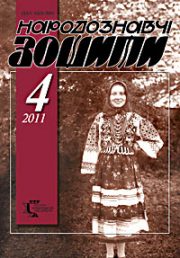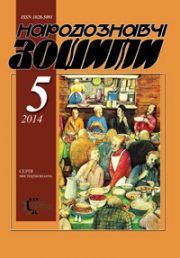The Ethnology Notebooks. 2019, № 6 (150), 1408—1419
UDK271.2-523.47(477. 83-22)”15″
DOI https://doi.org/10.15407/nz2019.06.1408
HELYTOVYCH Maria
ORCID ID: https://orcid.org/0000-0001-5839-9585
Candidate of Arts, Associate Professor
Head of the department of ancient Ukrainian art
Andrey Sheptytskyi National Museum in Lviv
Svobody avenue, 20, 79000, Lviv, Ukraine
e-mail: helytovychm@yahoo.com
Abstract. The article is devoted to one of the main problems in the study of the history of Ukrainian icon painting — the formation of the iconostasis into a multi-tiered structure, which is due to the relevance of the topic. Other issues related to the study of sacral painting, such as the activity of individual masters and workshops, features of iconography, etc., are also related to the article. The purpose of the research — based on the existing works and new, not yet explored monuments, is to analyze more fully one of the most fully preserved iconostasis ensembles of the late 16th — early 17th centuries, originating from the Church of the Transfiguration in Skole. And to reconstruct it, as well as to consider its artistic and figurative characteristics. A comparative analysis of the monuments refutes the existing claim of one authorship of a large group of stylistically related monuments. The involved method of dendrochronological analysis of wood made it possible to define more precisely the dating of the icons of this style. On the basis of the systematization of the monuments of museum and private collections, as well as the icons stored in the churches, a more precise number of them are given, the wider territorial boundaries of the monuments originating from the borders of the present Lviv region are defined. For the first time, a three-tier iconostasis from the church in Skole was reconstructed on the basis of all the surviving components not yet involved in scientific circulation. Participation in its creation of several painters is justified. The connections between this workshop and the workshop that operated in the years 1560—1570 are traced. It created an iconostasis from the Assumption Church. Finally — the most famous and most complete among the iconostasis of that time in Western Ukraine indicates a number of icons of other masters who operated in the same terrain and at the same time as the masters of the Skole complex. The article emphasizes the importance of exploring the iconostasis from Skole and the complex of related monuments as illustrative works that organically combine ancient traditions with new artistic pursuits focused on Western artistic culture. The iconographic features of the compositions of the holiday scenes are considered, the stylistic characteristics of the icons of the prayer series in comparison with other preserved fragments of the prayer series in this stylistic group of icons are noted. Based on the analysis of the new monuments, the existing assumption about the similarity of the icons of the «iconostasis workshop of the Church of the Transfiguration in Skole» with the paintings of` 1613 of the altar part of the Church of the Exaltation of the Holy Cross in Drohobych is confirmed.
Keywords: icon, iconostasis, master, tradition, iconography.
Received 7.11.2019
REFERENCES
Skop, L. (2004). Painter of the icon of the Virgin-Odigitria from Mrazhnycia. Lviv: Lohos [in Ukrainian].
Svientsitskyi, I. (1928). Galicia Ukraine Iconography of XV—XVI ages. Lviv [in Ukrainian].
Miliaieva, L., & Helytovych, M. (2007). Ukrainian icon of the XI—XVIII centuries. Kyiv [in Ukrainian].
Svientsitska, V, & Otkovych, V. (1991). Ukrainian folk painting of the 13th—20th centuries: The world through the eyes of the folk artists. Kyiv: Mystetstvo [in Ukrainian].
Patriarkh Dymytrii, (Yarema). (2017). Western Ukraine Iconography of XVI — beginning. XVII centuries. Lviv: Drukarski kunshty [in Ukrainian].
Helytovych, M. (2005). Virgin with Child and Praise (Collection of Icons of the National Museum in Lviv). Lviv: Svichado [in Ukrainian].
Helytovych, M. (2005). Ukrainian icons «Savior in Glory». Lviv: Drukarski kunshty [in Ukrainian].
Helytovych, M. (2008). Sviatyi Mykolai z zhytiiem. Lviv: Svichado [in Ukrainian].
Sydor, О. (2003). Ancient Ukrainian icon from private collections. Kyiv: Rodovid. [in Ukrainian].
Biskupski, R. (1991). Icons from the Historical Museum in Sanok collections. Warsaw [in Polish].
Miliaieva, L, Rishniak, O, & Sadova, O. (2019). St. George church in Drohobych. Architecture, painting, restoration. Kyiv: Vydavnytstvo [in Ukrainian].






